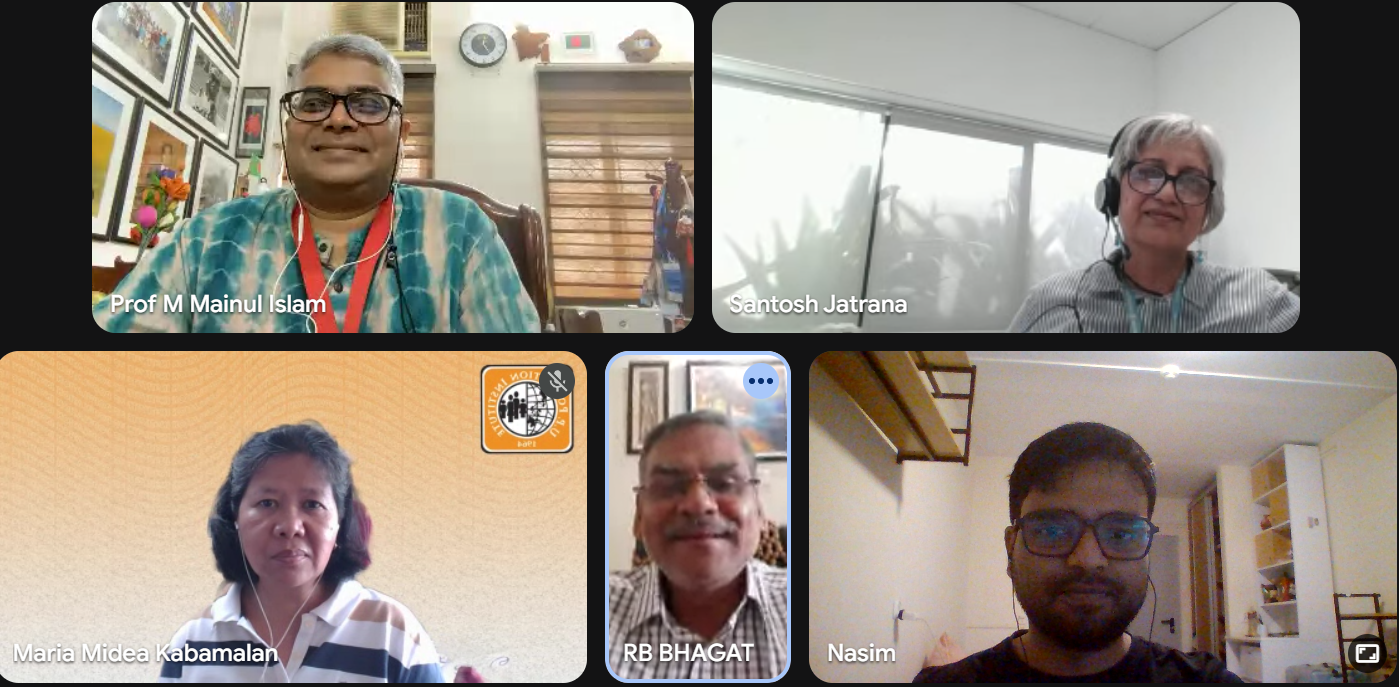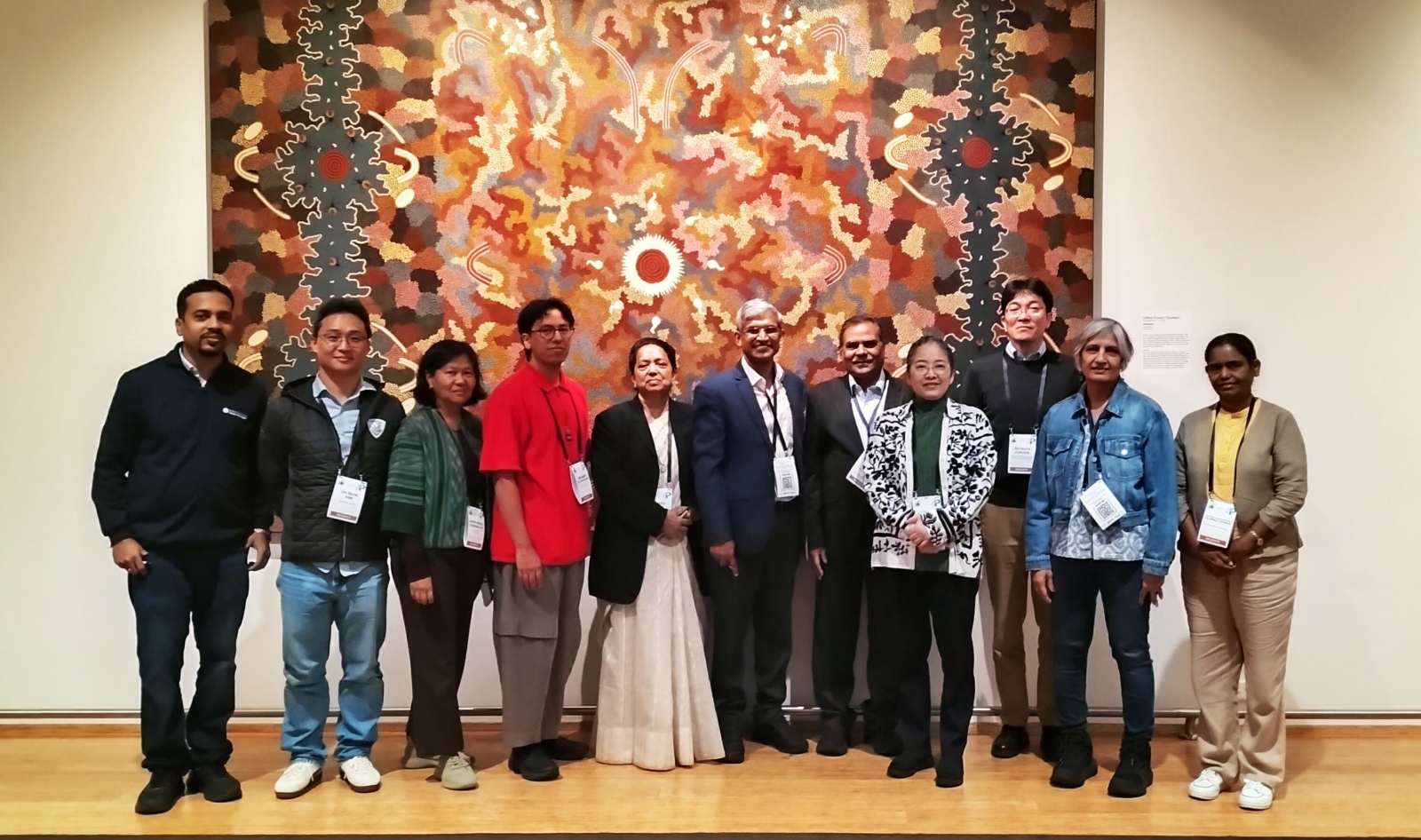- Home
- About APA
- Council
- Scientific Group
- Newsletter
- Publication
- Membership
- Conference
- Resource
- News
- Sitemap


- Home
- Scientific Groups
- APA Scientific Group on Climate Mobilities, Migrants and Health
APA Scientific Group
on
Climate Mobilities, Migrants and Health
Rationale:
Numerous studies show that climate change has made a serious impact on the biophysical diversity and the capacity of the ecosystem to provide food, livelihood and health security. As per the IPCC report (2022), the average global surface temperature has increased by over 1 degree C between 2010 and2020 compared to the pre-industrial level. It could rise to 1.5 degrees C by 2040. Scientists repeatedly warn that the world is on a 4-6 degrees C warming pathway, and robust mitigation and adaptation are continuously required. So far as Asia is concerned the average surface temperature has also been increasing, and this is also very much manifested in increased extreme weather events like droughts, floods, storms and cyclones and the erratic pattern of monsoon in Asia (IPCC, 2022).
People inhibit places that have evolved historically forging deep relationships with their environments. Climate change disrupts the close relationships between people and places, often creating new vulnerabilities and exacerbating the existing ones. While voluntary mobility and migration can reflect the capability to choose where to live or remain, not all movement is voluntary. Climate change often drives forced mobility—through internal displacement, refugee flows, asylum seeking, and even trafficking —undermining people’s ability to exercise agency over their lives. By eroding individual and collective capabilities, climate change threatens to disempower communities and hinder the realisation of social, cultural, economic and political rights. It raises profound concerns for environmental citizenship, reshaping the relationship between people and place through patterns of mobility and migration.
Climate change is likely to influence mobility and migration in two ways: ‘gradual’ and ‘sudden'. Gradual changes —including increasing aridity, desertification, loss of biodiversity, rising sea level —may prompt voluntary mobility and migration. In contrast, sudden events such as cyclones, floods and severe droughts, may lead to forced mobility, migration and displacement. Yet, such a binary distinction oversimplifies a complex reality. In truth, climate-driven mobility and migration are shaped by an intricate interplay of socio-economic and political factors, where climate change exacerbates pre-existing vulnerabilities rather than acting in isolation.
This scientific group would work on the premise that climate change should not be seen merely as a biophysical change, but must be viewed as embedded in the socio-economic conditions of affected populations. It means that adaptive capacity varies significantly across communities, and those facing socio-economic disadvantage are most likely to bear the brunt of climate impacts. There is a clear spatial overlap between regions most vulnerable to climate change, areas of deep socio-economic deprivations, and emerging patterns of mobilities and migration across the world, including in Asia.
Livelihoods dependent on agriculture, fisheries, livestock and forestry are increasingly at risk, driving migration as an adaptive strategy. Beyond voluntary migration, rising sea levels and extreme weather events are expected to cause large-scale displacement in both rural and urban areas. This scientific group will examine how these environmental pressures catalyse climate-induced mobility and migration, and identify strategies for mitigation and adaptation.
Importantly, the consequences of climate-related mobility and migration extend far beyond the act of moving. Both areas of origin and destination are likely to experience profound impacts. Health vulnerability is of particular concern, given the increased exposure to extreme weather events such as floods and heatwaves, disruptions to food system, growing water insecurity, and the increased risk of infectious diseases. Accordingly, this scientific group will also address the health outcomes among mobile and vulnerable populations, including those affected by forced displacement and planned relocations. Through its work, the group will contribute to the development of policies and programmes aimed at achieving climate justice, aligned with the Sustainable Development Goals’ commitment to ‘leave no one behind’.
Aims and Objectives:
- Climate change as a driver of mobilities and migrations is embedded with socio-economic and political drivers of migration. How to separate the effects of climate change drivers has been a real challenge of mobility and migration research.
- While voluntary (migration by choice) and involuntary movements (displacement and refugees) are often indistinguishable in many circumstances, researchers must take into account the gradual and sudden changes in the form of mobility and migration.
- Places of origin and destination, although closely related, methodologically raises questions that need to be addressed differently. While drivers of migration may be important for the areas of origin, the migrants may be relevant to be studied in the places of destination. The separation between the two assumes significance in the study of climate change as a driver and its impact respectively.
- Migration and other researchers face enormous challenges so far as secondary data at the areal level is concerned. Definitions of migration and migration intervals also vary widely across countries; the distinction between temporary and circular migration as a form of spatial mobility on the one hand, and migration as residential change on the other is rarely studied. This scientific group will endeavour to highlight that migration rarely occurs in a singular form but arises in multiple forms with varied drivers and impacts. This scientific group will highlight the limitations of current area-level secondary data, the inconsistencies in migration definitions across countries, and advocate for the use of innovative digital data and digital footprints to capture the full complexity of mobility.
- Mapping the relationship between people and places is crucial, yet reliable, up-to-date spatial data at lower administrative levels, such as town and ward, is often lacking, particularly in the non-metropolitan areas. This group will identify gaps in mapping and visualisation to support more informed urban planning and climate adaptation strategy.
- While the impacts of climate-related mobility and migration span multiple sectors —including livelihoods, food security, nutrition and health —this group will place a particular focus on the health consequences for mobile and vulnerable populations, both at the places of origin and destination.
Expectations and Outcomes (2025-2027):
This initiative aims to advance research, collaboration, and policy dialogue on the impacts of climate change on mobility, migration, and health across Asia. Through a series of strategic activities (detailed below)—including conferences, publications, collaborative research, capacity building, stakeholder engagement, and advocacy—the group will foster academic innovation, strengthen research networks, and inform evidence-based policy and practice.
i. Conference and Sessions:
Organize a high-profile international conference showcasing cutting-edge theoretical, methodological, and empirical research advances on the drivers and impacts of climate change on mobilities, migration and health in selected Asian countries. Key topics will include life-cycle mobility transitions driven by extreme weather events, and policy responses for mitigation and adaptation at both origin and destination regions. In addition to the flagship conference, the group shall also organise specialised sessions at major international forums such as IUSSP, APA, PAA, IGU.
ii. Edited Book or a Special issue in a Journal:
Papers presented at the conferences and sessions organised by this group will be published either as an edited book or as articles in a special issue of a leading academic journal.
iii. Research Collaboration and Grant Development:
Strengthen international research collaboration by developing a joint research proposal on climate-related mobility, migrant and health. This proposal will target major external funding opportunities, working in partnership with renowned academic institutions and research networks.
iv. Capacity Building Workshop:
Host a specialised capacity-building workshop aimed at enhancing the methodological and analytical skills of PhD scholars and early-career researchers working in the fields of climate mobility, migrant and health.
v. Stakeholder Engagement and Networking:
Establish regular online dialogues with key stakeholders—including government agencies, academic institutions, UN bodies, the Asia-Pacific UN Migration Network, and civil society organisations—to foster collaboration, knowledge exchange and evidence-based policy dialogue.
vi. Advocacy and Outreach:
Strengthen advocacy and outreach efforts by disseminating research findings, promoting events, and publishing blogs, newsletters, and commentary pieces to broaden the group’s visibility and policy impact.
Global Perspectives and Resources:
IOM, Global Compact for Safe, Regular and Orderly Migration, https://www.iom.int/global-compact-migration
UNHCR, Global Compact on Refugees, https://www.unhcr.org/in/who-we-are/global-compact-refugees
WHO, Refugee and Migrant Health, https://www.unhcr.org/in/who-we-are/global-compact-refugees
Barriers and Risks of Health for Migrants

Source: WHO (2022) World Report on the Health of Refugees and Migrants, Geneva.
Determinants of Health in Different Phases of Migration

Source: WHO (2022) World Report on the Health of Refugees and Migrants, Geneva.
Minutes of Meeting Date: 28 July 2025
Download

APA Council Liaison:
Maria Midea Kabamalan, Professor, University of the Philippines, (This email address is being protected from spambots. You need JavaScript enabled to view it.)
APA Secretariat Office
Institute for Population and Social Research,
Mahidol University, Salaya Campus, Phutthamonthon,
Nakhon Pathom, 73170 Thailand  This email address is being protected from spambots. You need JavaScript enabled to view it.
This email address is being protected from spambots. You need JavaScript enabled to view it.
Copyright © 2021 Asian Population Association
Visitor Info
Starting on April 1, 2021
361110 times

